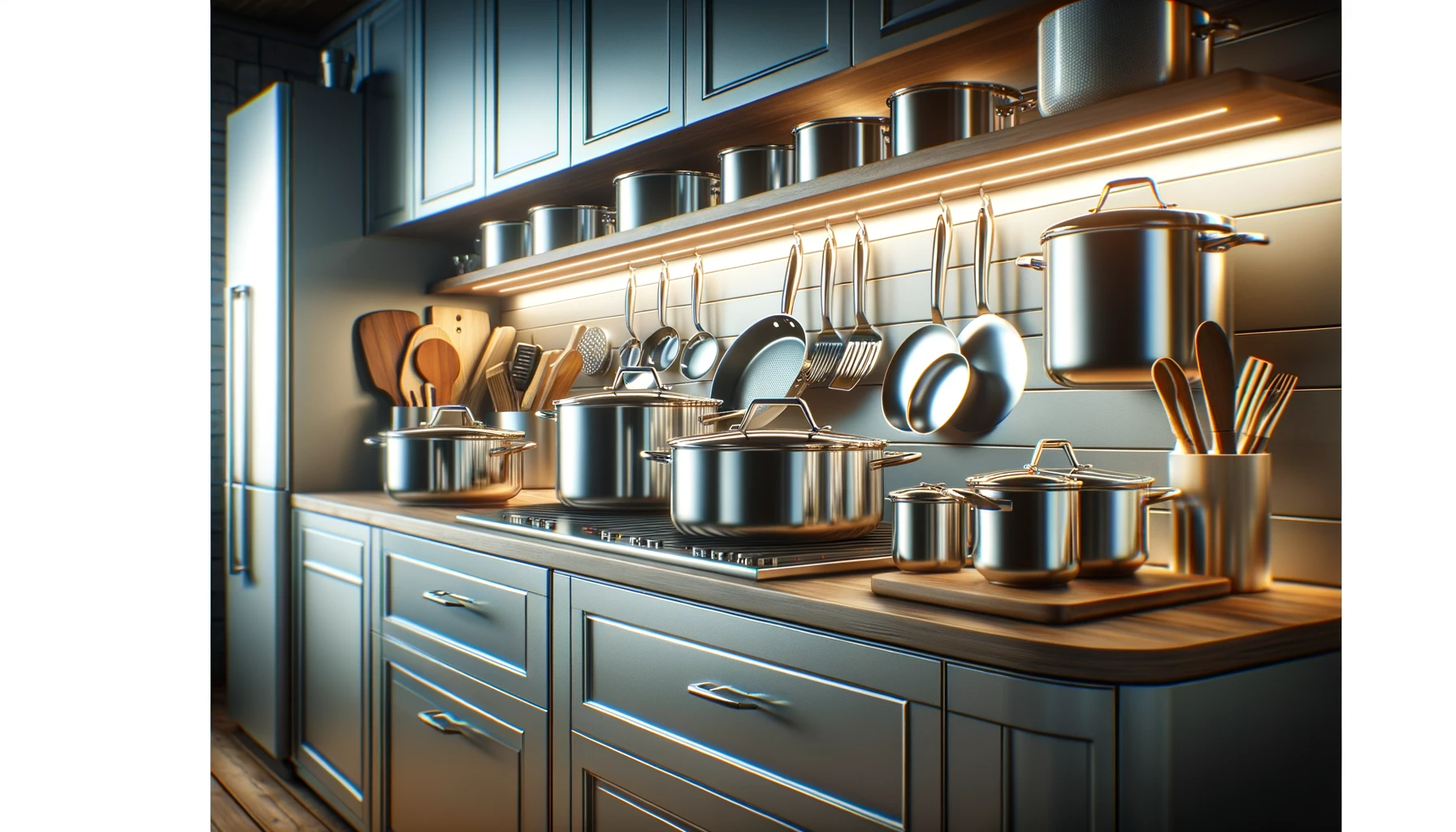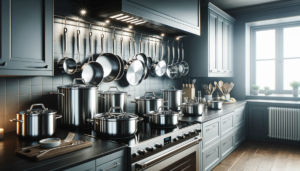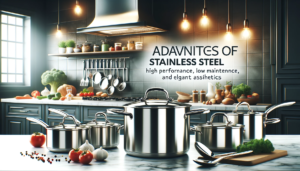Have you noticed small pits, spots or stains appearing on your shiny new stainless steel pans? These early signs of damage might make you wonder if you made a poor investment.
But don’t worry – with some simple care and precautions, you can prevent pitting corrosion and keep your cookware looking brand new.
Understanding what causes pitting in stainless steel along with implementing protective cleaning, cooking, and storage methods allows you to safeguard your purchase’s longevity and appearance.
Let’s dive into the top tips for preventing stainless steel pitting and corrosion so your cookware stays pristine.
How to Prevent Pitting in Stainless Steel Cookware?
You can prevent pitting in stainless steel cookware by properly seasoning, using non-abrasive cleaning methods, avoiding cooking highly acidic ingredients, cleaning promptly after cooking, and storing carefully to prevent scratches and dents.
Implementing these basic care steps helps maintain the protective layer on stainless steel to guard against corrosion over time.
Below we’ll explore these pitting prevention tips in more detail, outlining simple habits you can build into your cooking and cleaning routines.
Properly Season Your Cookware

Seasoning your stainless steel cookware creates a protective layer that prevents pitting and corrosion.
It fills in microscopic pores and issues in the steel, creating a slick nonstick finish.
Seasoning is quite easy to do at home.
First, you’ll want to wash the stainless steel cookware thoroughly before starting the process.
Use hot water and dish soap to clean the inside surfaces, exterior bottom, and handles.
Scrub away any stuck on residues or food stains with a soft sponge or cloth.
After washing, rinse pans completely then dry very thoroughly with clean dish towels.
Make sure pots and pans are completely dry before seasoning.
Water droplets or moisture can impact how well the oil seals the surface later.
Heat pans slightly to evaporate any remaining moisture if needed.
For seasoning, you’ll need a high smoke point cooking oil like canola, vegetable, avocado or refined coconut.
Avoid extra virgin olive oil or butter which can burn or create stains.
Pour a tablespoon or so of oil into each pan, using less for skillets and more for stockpots.
Then rub the oil all over interior cooking surfaces using a paper towel or soft lint-free cloth.
Try to cover every inch possible, rubbing oil into corners, edges, and sides.
Get a very thin and even coat across the entire area your food will touch.
Once oiled, place pans upside down on the middle rack of your oven.
Bake them for an hour at a low 200-250°F to fully polymerize and set the oil.
The low gentle heat helps bond the coating evenly without burning.
If oil starts smoking, your oven temp is too high.
After an hour, turn off the heat and allow pans to cool fully before removing.
The oil helps seal the microscopic pores that allow staining and pitting corrosion issues over time.
It’s best to repeat the seasoning process every 4-6 months to maintain that protective coating as it can slowly wear down from acidic foods or scrubbing.
Re-seasoning takes little effort, adds great protection, and keeps pans looking brand new for years.
It’s the easiest way to care for higher end stainless steel cookware.
Use the Right Utensils
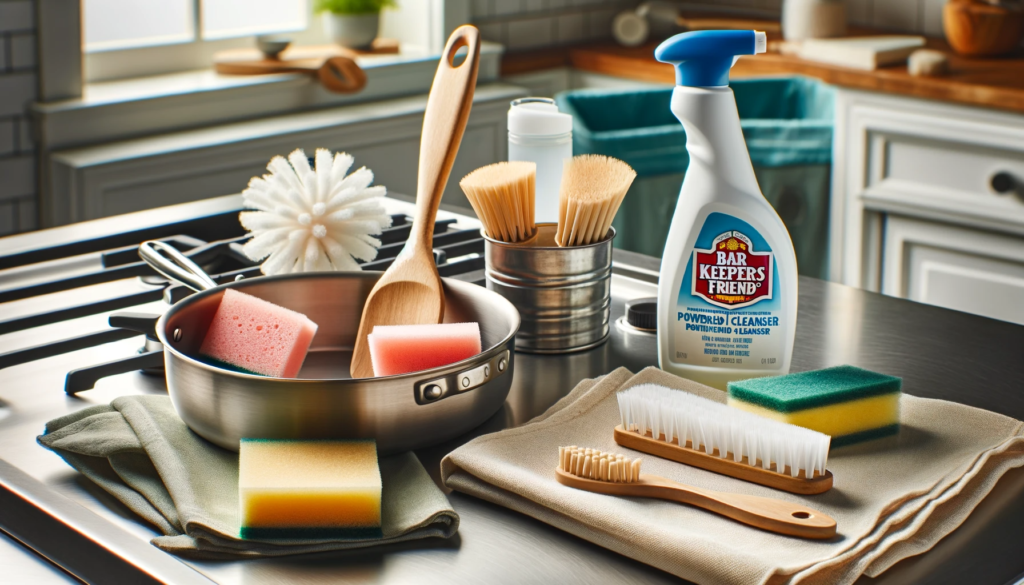
Using overly abrasive scouring pads, stiff scrub brushes, or harsh chemical cleaners can scratch and wear down stainless steel surfaces over time.
This damages the protective top layer, allowing pitting, corrosion and visible scratches to occur.
To prevent this, always use soft sponges, plastic brushes, wooden spoons, silicone scrapers and other gentle cooking/cleaning tools.
This keeps the stainless steel surface intact without weakening scratches and divots that impact appearance and durability.
When facing stubborn cooked-on messes, you can use a powdered stainless steel cleanser to help lift residues gently without damaging the surface itself.
Bar Keepers Friend is a popular powder formula designed specifically for stainless cookware.
Just sprinkle some powder onto stuck on spots like burned cheese or grease splatters.
Then take a soft, damp sponge or cloth and gently rub the area using light circular motions to lift the mess away safely.
The abrasive powder does the tough work so you won’t have to scrub aggressively yourself.
Be sure to rinse pans very thoroughly after using any cleaning powder too.
Chemical residues can interact poorly with stainless steel over time, breaking down the protective layer.
And fully dry with a dish towel as moisture corrosion is an issue.
Taking care in your daily cooking habits makes a difference in keeping stainless looking beautiful for the long run.
Harsher pads like steel wool may work faster, but the microscopic damage done means pans lose their luster sooner.
Don’t Cook Acidic Foods
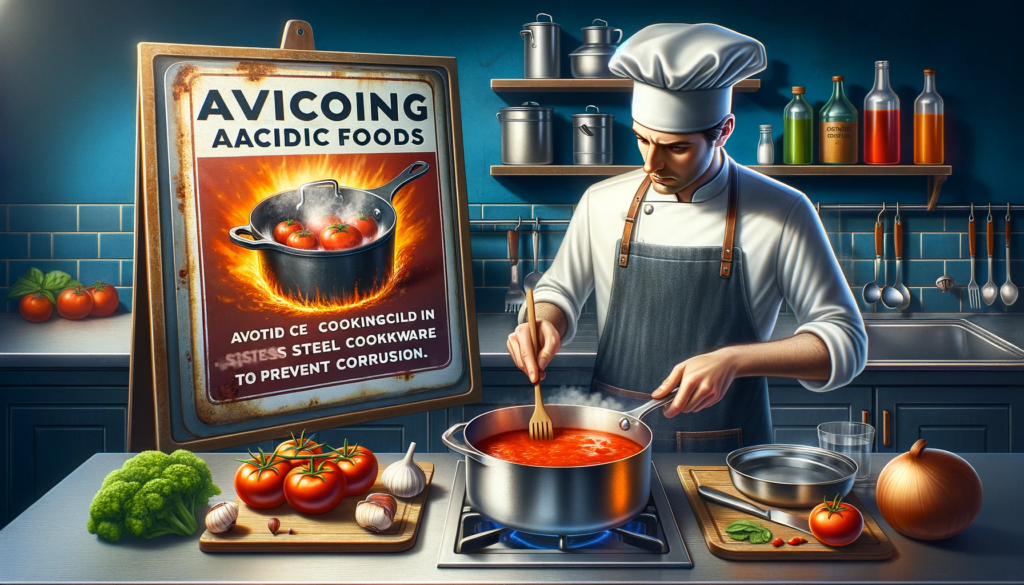
While stainless steel cookware is low maintenance overall, highly acidic ingredients can start breaking down the protective later and lead to staining, corrosion issues over time.
Ingredients like tomatoes, citrus juices, vinegars, wines and some pickled can be problematic if cooked directly in stainless pots or pans frequently and not cleaned promptly.
The increased acidity interacts poorly with stainless steel, causing pitting and visible wear even with proper scrubbing.
To prevent this, it’s best to cook recipes with a higher acidic content in enamel coated cast iron or ceramic nonstick pans instead which offer greater resistance.
The enameling creates an impervious barrier between food and the actual metal itself.
So tomato-based sauces, fruit compotes with vitamin C-rich fruits, or dishes with wine or vinegar can be prepared safely without risk of corrosion down the road.
If you do end up with some acidic food residues stuck to stainless steel, be sure to wash the pan immediately by hand with hot soapy water.
Give it a good scrub with a soft sponge or cloth to remove all traces left behind.
Letting high acid foods linger too long on stainless steel gives the ingredients more opportunity to start breaking down the protective finish.
Get in the habit of hand washing pans used for acidic dishes within an hour of cooking, using hot sudsy water and gentle scrubbing.
This prevents long term issues like blue or black pits, permanent staining or visible wear which compromise both appearance and performance.
Skipping stainless steel with tomatoes sauces is an easy fix to prevent deterioration over time.
Clean Properly After Cooking
How you care for stainless steel cookware after each use can prevent or minimize pitting and corrosion issues that develop over years of use.
Cleaning is just as important as your actual cooking method for keeping stainless in good condition for the long term.
Avoid using super abrasive scouring pads or stiff scrub brushes which scratch the surface, damaging protective layers.
Use hot water, mild dish soaps, and soft sponges or cloths only when addressing stuck on residue.
Then rinse and dry thoroughly, preventing water mineral stains left behind.
Ideally, hand wash stainless pans right after cooking while still warm which lifts food soils better before burning or drying on.
Letting food residue linger too long makes cleanup far harder.
Place warm pans into a sink filled with hot, soapy water first.
This give soils time to soften up for easier removal.
Allow to soak for 5-10 minutes, using a dish wand to gently lift and dissolve any bits stuck to the interior.
This softens burned or crusty spots better than cold water without much elbow grease needed later.
After soaking, use soft dish sponges and nylon brushes to gently remove remaining residues without damaging the surface itself.
Avoid anything too abrasive or harsh
This finishes cleanup without weakening the stainless steel’s protective top layer over time through microscopic scratches.
Get into ridges, edging and other grease-catching areas for thorough cleaning.
Next always rinse very thoroughly after washing to remove all soap residues which can interact poorly with stainless too.
Fully drying immediately with clean dish towels prevents water mineral corrosion and keeps that just-cleaned shine looking its best.
Putting some extra care into post-cooking habits keeps pans far cleaner and aids longevity overall.
Store Cookware Properly
How and where you store stainless steel cookware plays an important role in preventing external damage that leads to pitting and issues later on.
Dents, warping and scratches from other objects makes them more vulnerable to staining and deterioration during use.
Use padded shelves liners, storage racks and pan organizers to prevent hard contact with other items in cabinets.
Line the bottom of pot drawers or shelves with towel layers create a soft protective barrier.
You can also slip pans inside one another for stacking, using parchment rounds or paper towels between to prevent direct scraping or scratching of surfaces.
Heavier stockpots should go on the bottom to prevent weight-related dents.
Implementing storage solutions protects the integrity of the stainless steel’s top layer over years of ownership.
Avoid placing other kitchen tools, glassware or heavy items directly on top of stainless steel cookware in cabinets.
Added weight over time can cause denting which leads to surface damage.
Instead use lids, removable racks or cabinet risers to neatly separate everything apart.
Prevent pots and pans from scraping together through strategic organization.
Group like items with the same metal type together, keeping the stainless isolated from other reactive materials.
Be mindful of where you place hot stainless steel cookware immediately after cooking too.
Setting a 400°F pan directly on quartz countertops or travertine tile can damage delicate surfaces.
Allow pans to fully cool first on pot holders before touching down elsewhere.
Metal expands when overheated, so drastic temperature shifts during can also warp cookware, taking away from appearance and durability.
Being careful where rested while hot prevents unnecessary damage down the road.
Conclusion
Caring for stainless steel cookware properly is key to preventing unsightly pitting and corrosion issues over time.
Take time to season pans, use gentle cleaning methods, avoid cooking acidic recipes, and implement strategic storage solutions.
With some simple preventative habits, your stainless steel can stay shining like new for years of cooking enjoyment.
Treat your expensive pots and pans with care and they’ll reward you with longevity.
